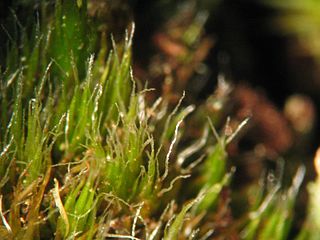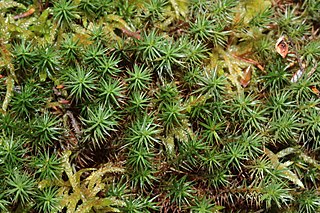
Spearmint, also known as garden mint, common mint, lamb mint and mackerel mint, is a species of mint, Mentha spicata (, native to Europe and southern temperate Asia, extending from Ireland in the west to southern China in the east. It is naturalized in many other temperate parts of the world, including northern and southern Africa, North America, and South America. It is used as a flavouring in food and herbal teas. The aromatic oil, called oil of spearmint, is also used as a flavoring and sometimes as a scent.

Alopecurus pratensis, known as the meadow foxtail or the field meadow foxtail, is a perennial grass belonging to the grass family (Poaceae). It is native to Europe and Asia.

Viola canina is a species of the genus Viola, native to Europe, where it is found in heaths, fens, and moist woodlands, especially on acidic soils.

Spiraea douglasii is a species of flowering plant in the rose family native to western North America. Common names include hardhack,hardhack steeplebush, Douglas' spirea, douglasspirea, steeplebush, and rose spirea.

A seedling is a young sporophyte developing out of a plant embryo from a seed. Seedling development starts with germination of the seed. A typical young seedling consists of three main parts: the radicle, the hypocotyl, and the cotyledons. The two classes of flowering plants (angiosperms) are distinguished by their numbers of seed leaves: monocotyledons (monocots) have one blade-shaped cotyledon, whereas dicotyledons (dicots) possess two round cotyledons. Gymnosperms are more varied. For example, pine seedlings have up to eight cotyledons. The seedlings of some flowering plants have no cotyledons at all. These are said to be acotyledons.

Viola palustris is a perennial forb of the genus Viola. It inhabits moist meadows, marshes, and stream banks in northern parts of North America and Eurasia. The species epithet palustris is Latin for "of the marsh" and indicates its common habitat.

The Sciaridae are a family of flies, commonly known as dark-winged fungus gnats. Commonly found in moist environments, they are known to be a pest of mushroom farms and are commonly found in household plant pots. This is one of the least studied of the large Diptera families, probably due to the small size of these insects and the similarity among species.

Populus trichocarpa, the black cottonwood, western balsam-poplar or California poplar, is a deciduous broadleaf tree species native to western North America. It is used for timber, and is notable as a model organism in plant biology.

Campylopus introflexus, also known as the heath star moss, is a species of moss. The first description of the species was made by Johannes Hedwig as Dicranum introflexum in 1801.

Thelypodium stenopetalum is a rare species of flowering plant in the mustard family known by the common names slenderpetal thelypody, slender-petaled thelypodium and slender-petaled mustard. It is endemic to the San Bernardino Mountains of southern California, where it is known from only three or four extant occurrences in moist mountain meadows near Big Bear Lake. Its remaining habitat is considered seriously threatened and the plant is a federally listed endangered species in the United States.
Stylidium darwinii is a small, erect annual plant that belongs to the genus Stylidium. It grows up to 4.5 cm (1.8 in) tall. Elliptic-oblong or obovate to orbicular leaves are scattered and alternate along the simple, glabrous stem. The leaves are generally 2–3 mm long and 1.5-1.8 mm wide. Inflorescences produce many violet-pink flowers, which flower from September to November. Stylidium darwinii is only known from Anshi National Park in the Uttara Kannada district of Karnataka, India. Its habitat is recorded as being moist gravelly soils on the outskirts of evergreen forests near roadsides at an altitude of 530 m (1,739 ft). It can be found in association with several carnivorous plant species, including Drosera burmannii, Drosera indica, and Utricularia caerulea. The specific epithet darwinii was given to this species in honor of Charles Darwin.

Lobaria scrobiculata, commonly known as the textured lungwort, is a large foliose, epiphytic lichen in the family Peltigeraceae.

Polytrichum strictum, commonly known as bog haircap moss or strict haircap, is an evergreen and perennial species of moss native to Sphagnum bogs and other moist habitats in temperate climates. It has a circumboreal distribution, and is also found in South America and Antarctica.
Atrichum angustatum is a species of mosses belonging to the family Polytrichaceae.

Polytrichum piliferum, the bristly haircap, is an evergreen perennial species of moss in the family Polytrichaceae. The bristly haircap moss is small-sized to medium-sized and forms loose tufts with wine-reddish stems. It is an acrocarpous moss that appears bluish-green to grey. This moss grows in clumps on erect shoots and becomes a red-brown colour as it grows older. The most distinguishing feature of P. piliferum is the long, white awn at the tips of the leaves, which also give this moss its grey colour. It is the only species in its genus where the awn is completely hyaline.

Primula stricta, also known as the strict primrose, is a species of flowering plant in the family Primulaceae.

Telekia speciosa, also known as the heart-leaved oxeye or yellow oxeye, is a species of flowering plant within the family Asteraceae.

Helichrysum monogynum, also known as red tinderbox, is a species of flowering plant within the family Asteraceae. The species is listed as endangered due to its restricted range within 8 km² of suitable habitat and the threat of habitat degradation due to urbanisation and recreational activities.

Primula glutinosa, also known as the sticky primrose, is a species of flowering plant within the family Primulaceae.

Taraxacum ceratophorum, also known as the horned dandelion, is a species of flowering plant within the genus Taraxacum and family Asteraceae. This alpine species has a preference for mountainous habitat, where it can be found growing at elevations up to 3000 meters above sea level. It is native to a large portion of the Northern Hemisphere, inhabiting various countries within Asia, Europe and North America.


















